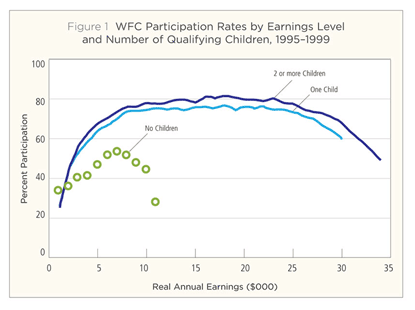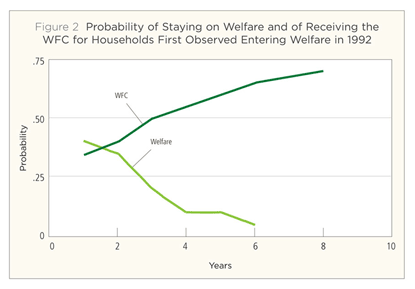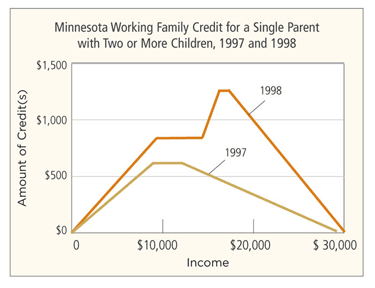Earned income tax credits are tax credits for individuals who work but have relatively low earnings. The credits serve as a work incentive by raising after-tax earnings, lowering income taxes owed, and in some cases resulting in a refund check that may help individuals pay for expenses.
This article highlights some of the supporting efforts and research dedicated to earned income tax credits, with particular emphasis on research into receipt rates among welfare recipients in Minnesota, where a substantive body of research has been conducted on state earned income tax credits and where the diverse economy and varied rural-metropolitan populations combine to form a microcosm of conditions in many other regions of the nation. The research suggests that lower incomes and other characteristics of welfare recipients who work make them less likely to receive the credit, compared to eligible individuals not on welfare. Nonetheless, according to data from the 1990s, most Minnesota welfare recipients eventually left welfare and received the earned income tax credit along the way, even though the typical speed of these transitions differed by education level, family structure, and other demographic variables.
A network of support
As of the 2010 tax-filing season, the federal government, 23 states, the District of Columbia, and two local governments offered earned income tax credits.1/ Of the six states in the Ninth Federal Reserve District, Michigan, Wisconsin, and Minnesota currently offer credits of this type.
In a small storefront office in Minnesota's capital city of St. Paul, a young mother and welfare recipient named Tania works on her taxes with a volunteer preparer. The office, known as a VITA (Volunteer Income Tax Assistance) site, offers free tax preparation services to eligible individuals, including people with low earnings. Tania has come to the site to seek help in filing her tax returns and receiving federal and state earned income tax credits.
In addition to the volunteers who staff VITA sites, a large network of individuals is working to help make earned income tax credits an effective policy for people with lower earnings. Across town from the site where Tania is working on her taxes, representatives from nonprofit organizations; city, county, state, and federal agencies; and local universities form a working group that meets to consider ways to raise awareness and utilization of earned income tax credits. In state and federal legislative offices, legislators meet with staff to decide on the level of earned income tax credits. Throughout the country, researchers from universities, government offices, and nonprofit organizations provide information about the costs and benefits of earned income tax credits in order to support policymakers and, ultimately, help low-income individuals like Tania.
A continuing incentive to work
As noted above, earned income tax credits raise the incentive to work by lowering income taxes owed or, in some cases, resulting in a refund check. The credit begins at zero dollars for individuals without earnings. It then increases as earnings increase until it reaches a maximum, where it stays until earnings reach a threshold. The credit then diminishes back to zero. Researchers have found that federal and state earned income tax credits and their accompanying incentive to work have raised the employment rate of single mothers, reduced the rate of child poverty, and helped reduce welfare caseloads in the post-welfare reform era. Some of the research on Minnesota's earned income tax credit, the Working Family Credit (WFC), has focused on how many welfare recipients like Tania actually receive the credit.2/ Earned income tax credits may be especially relevant for Tania and other parents on welfare, since they are still eligible for the credit even after they have too much in earnings to qualify for welfare. Therefore, the credits provide a continuing incentive to work, even after parents leave welfare.
Historically, about 3 out of every 4 eligible individuals receive the earned income tax credit, which is a higher participation rate than that of most other programs aimed at low-income people, such as the former Food Stamp Program (now known as the Supplemental Nutrition Assistance Program, or SNAP) and Medicaid.3/ However, although earned income tax credits have been found to help parents stay off welfare, parents on welfare are less likely to receive them. For example, in Minnesota, roughly 62–66 percent of welfare recipients eligible for the WFC in a given year actually received it.
Benefits and costs
A significant number of parents on welfare do not receive earned income tax credits even when they are eligible.4/ So what accounts for this? Some researchers suggest that, at least in theory, individuals including parents on welfare will receive earned income tax credits as long as the benefits of receiving the credits outweigh the costs.5/ The benefits are the earned income tax credit dollars, which provide a financial boost for low-income families. The dollars can reduce end-of-year taxes owed, or in states like Minnesota where the income tax credit is refundable, some parents receive a refund, which may help pay for expenses.
The costs of receiving an earned income tax credit include more than the money that individuals pay for tax preparers, software packages, or pencils and pens. They include the work needed to receive the credit, such as finding tax records, gathering receipts, and filling out tax forms. Costs also more broadly include a lack of information about earned income tax credits, including the WFC. If parents on welfare have to expend additional effort to become informed about earned income tax credits, they may be less likely to file income tax returns and receive the credits. Across the nation, tax credit proponents are pursuing efforts to reduce these information costs. For example, the working group in Minnesota disseminates fliers about the federal and state earned income tax credits that are written in multiple languages and inform potential recipients about the amounts of the credits.
Another explanation for why parents on welfare receive earned income tax credits at comparatively low rates is that at any point in time, they have less in earnings than other low-income people, which makes them eligible for less in their state's earned income tax credit and thereby reduces the benefit of receiving the credit. However, this does not mean that all parents on welfare will be eligible for little in state earned income tax credits for the rest of their lives. Welfare recipients' earnings can increase over time. For example, in examining data on 1992 entrants into Minnesota's former welfare program, Aid to Families with Dependent Children, researchers find that the median distribution of real earnings rises from $9,968 in 1996, the fourth year past entry, to $16,641 in 1999, seven years after entry. Perhaps still a modest level of earnings, but nonetheless one where parents with two or more children would be eligible for a larger earned income tax credit even after accounting for inflation.
Picturing the percentages
The graphs below depict some key facts about WFC receipt rates among welfare recipients. For the period 1995–1999, Figure 1 shows the percentage of current and former welfare recipients who receive the WFC by earnings level and number of children. The graph lists separate amounts by number of children, since the state and federal earned income tax credits pay different amounts based on whether the individual has zero, one, or two or more qualifying children. The highest amounts are paid to parents with two or more qualifying children.
Click on chart to view larger image
From the graph, parents on welfare who have two or more qualifying children and earnings below $5,000 receive the credit at rates below 65 percent. In comparison, between 75 and 80 percent of parents on welfare who have two or more children and earnings between $10,000 and roughly $25,000 receive the WFC. For earnings higher than $25,000, WFC receipt percentages begin to drop off again. Some of the drop-off could be due to the effects of other income that may contribute to a parent's ineligibility for the state earned income tax credit.
Eventually, the majority of parents who are on Minnesota's current welfare program, the Minnesota Family Investment Program (MFIP), end up exiting it. And eventually, the majority of parents who received MFIP benefits receive the WFC at least once. Figure 2 compares the estimated probability of a parent remaining on welfare with the estimated probability of that parent receiving the WFC after his or her first day of entrance into the MFIP.6/ The graph indicates that as time passes, parents are less likely to remain on welfare and more likely to receive the WFC. Eight years after their first entrance into welfare, roughly 75 percent of the parents will have received the credit.
Click on chart to view larger image
However, it takes some parents more years to begin receiving earned income tax credits than others. Among current and former welfare recipients, household heads who are more likely to take the longest time before receiving the WFC include African Americans, American Indians, Asian Americans, males, single parents, teenage parents, individuals without a high school diploma, and parents with children five years old and younger. Many of these are the same characteristics of parents who stay longer on welfare than other parents and who do not receive the state earned income tax credit in any single year.
Where do we go from here?
Three main policy issues arise from the research on Minnesota's earned income tax credit. One, how can policymakers help moms like Tania and other individuals who experience poverty move out of poverty in the quickest and most permanent fashion? Research suggests that legislative enactments to increase the generosity of the WFC may increase utilization, and other research suggests the WFC helps individuals on welfare enter the labor force. However, to minimize the costs of the program and best assist low-income families, it would also be helpful to find ways to make the WFC result in a faster, more permanent escape from poverty. Second, how can earned income tax credits help those who end up never having much in earnings? Since some parents may take a long time to increase their earnings, it may be helpful to find ways to assist those who are stuck at low earnings levels and least likely to ever receive the credits. And third, how can proponents and policymakers raise receipt of earned income tax credits among eligible parents? There is some evidence that VITA sites and other free tax preparation sites may help. For example, holding all other things constant, parents who live in communities with higher poverty rates and high concentrations of free tax preparation sites exhibit higher utilization rates.
These policy issues point to further areas for earned income tax credit researchers to explore. The more researchers do to expand their understanding of the utilization and effects of earned income tax credits, the better they can inform the web of policymakers, advocates, and others who are dedicated to making the credits work for Tania and other low-income individuals.
A costly credit?Although earned income tax credits are a potentially useful tool in helping welfare recipients and other low-income individuals find employment and raise their income levels, some observers note that earned income tax credit programs pay out a considerable amount of money that could be used for other purposes. For example, for tax year 2008, over $172 million was claimed in Minnesota's earned income tax credit—the Working Family Credit (WFC)—by more than 297,000 returns, which averages to $581 per claimant's return. However, WFC proponents note that since individuals are more likely to be employed and have taxable earnings because of earned income tax credits, at least some of the credit dollars Minnesota paid out would not have been collected in the first place if the WFC program did not exist. |
The shape of earned income tax creditsThe size of earned income tax credits usually follows three stages, which are illustrated by the lower curve on the graph below. First is the phase-in stage, in which eligibility for the credit begins as parents begin to have earnings. The credit then increases at a constant percentage as earnings increase, until it reaches stage two, the phase-out floor, where it remains at a maximum level until earnings reach a designated phase-out point. In the third stage, the credit phases out to zero as earnings continue to increase. The amount of most state earned income tax credits is calculated as a flat percentage of the federal earned income tax credit. For example, Michigan's earned income tax credit is 20 percent of the federal earned income tax credit. In 1998, Minnesota switched from the usual single-tier shape to one that includes a second maximum tier or bump. This additional tier provides extra income when parents exit other benefit programs, such as the food and cash portions of the Minnesota Family Investment Program. In the graph below, the upper curve represents Minnesota's current, two-tier program. |
Balancing two approaches to the dataTo create an accurate picture of earned income tax credits, it seems logical to use the most current data available. So why does this article rely partly on data from the 1990s and early 2000s instead of more recent numbers? The answer lies in the approaches different groups of researchers take toward the data they use. For researchers who are interested in identifying and tracking recent trends, the timeliness of data is paramount. Researchers in this group rely on recently released data from sources such as the federal government. While these researchers' findings are valuable, the data they are based on do not always undergo extensive review to ensure their reliability. Also, the data are often aggregated in a way that may provide less information on individual-level behavior. For researchers who are interested in understanding long-term trends, data quality is the top priority. These researchers use extensive checks and reviews to ensure the reliability of the data that underlie their findings. The review process helps ensure a high level of accuracy, but it can take a long time—so long, in fact, that the findings might not be released until years after the source data were originally made available. Each approach has merits that are useful for understanding the receipt of earned income tax credits. This article aims for a balance between the two approaches by relying on the most recently available findings from both of them. |
1/ Jason Levitis and Jeremy Koulish, State Earned Income Tax Credits: 2008 Legislative Update, Center for Budget and Policy Priorities, October 2008.
2/ For the purposes of this article, "receive" involves two actions: An eligible individual first files for an earned income tax credit, and the government then issues the individual a credit.
3/ "IRS Marks EITC Awareness Day; Highlights Expanded Tax Credit," IRS News Release, January 28, 2010. Earlier reports suggest the range may be slightly higher—between 80 and 86 percent. For example, see Alan Berube, The Earned Income Tax Credit at Age 30: An Overview, Brookings Institution, February 8, 2006. Research on SNAP is in its early stages. For example, see Sheila R. Zedlewski, Recent Trends in Food Stamp Participation: Have New Policies Made a Difference? Urban Institute, originally published in May 2004 and updated with more recent data.
4/ For example, see Jeffrey B. Liebman, "The Impact of the Earned Income Tax Credit on Incentives and Income Distribution," Tax Policy and the Economy, Volume 12, edited by James M. Poterba, SB/SE Research; and Participation in the Earned Income Tax Credit Program for Tax Year 1996, Fiscal Year 2001 Research Project No. 12.26, Internal Revenue Service, January 2002.
5/ Janet Currie, The Take-Up of Social Benefits, National Bureau of Economic Research Working Paper No. W10488, May 2004.
6/ These probabilities were constructed by examining data on parents who first entered welfare in 1992.








